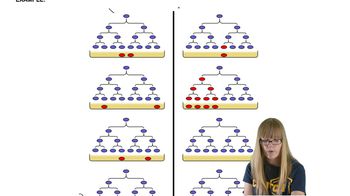What insights have analyses of human mitochondrial DNA provided into our recent evolutionary past?
Table of contents
- 1. Introduction to Genetics51m
- 2. Mendel's Laws of Inheritance3h 37m
- 3. Extensions to Mendelian Inheritance2h 41m
- 4. Genetic Mapping and Linkage2h 28m
- 5. Genetics of Bacteria and Viruses1h 21m
- 6. Chromosomal Variation1h 48m
- 7. DNA and Chromosome Structure56m
- 8. DNA Replication1h 10m
- 9. Mitosis and Meiosis1h 34m
- 10. Transcription1h 0m
- 11. Translation58m
- 12. Gene Regulation in Prokaryotes1h 19m
- 13. Gene Regulation in Eukaryotes44m
- 14. Genetic Control of Development44m
- 15. Genomes and Genomics1h 50m
- 16. Transposable Elements47m
- 17. Mutation, Repair, and Recombination1h 6m
- 18. Molecular Genetic Tools19m
- 19. Cancer Genetics29m
- 20. Quantitative Genetics1h 26m
- 21. Population Genetics50m
- 22. Evolutionary Genetics29m
22. Evolutionary Genetics
Phylogenetic Trees
Problem D.6
Textbook Question
Consider possible societal and ethical dilemmas that might arise if we currently shared the planet with another hominin.
 Verified step by step guidance
Verified step by step guidance1
Recognize that this problem is not directly related to genetics or scientific problem-solving but rather involves societal and ethical considerations about coexisting with another hominin species.
Understand that hominins refer to members of the human lineage after the split from the common ancestor with chimpanzees, including species like Homo neanderthalensis and Homo erectus.
Consider how genetic similarities and differences between modern humans and another hominin species could influence social interactions, reproduction, and health.
Reflect on ethical dilemmas such as rights, identity, discrimination, and resource sharing that might arise from cohabitation with another intelligent hominin species.
Think about how genetic research and knowledge could inform policies and ethical frameworks to address coexistence challenges, but note that this is more a topic of ethics and social science than genetics problem-solving.
 Verified video answer for a similar problem:
Verified video answer for a similar problem:This video solution was recommended by our tutors as helpful for the problem above
Video duration:
3mPlay a video:
Was this helpful?
Key Concepts
Here are the essential concepts you must grasp in order to answer the question correctly.
Hominin Evolution and Diversity
Hominins are members of the human lineage after diverging from the common ancestor with chimpanzees. Understanding the diversity of hominin species, such as Neanderthals and Denisovans, provides context for how different human-like species coexisted and interacted, which is essential when considering societal dynamics with another hominin.
Recommended video:
Guided course

Evolution
Ethical Considerations in Coexistence
Ethical dilemmas arise when considering rights, treatment, and social inclusion of another intelligent hominin species. Issues include defining personhood, moral obligations, and potential discrimination, which are critical for evaluating how societies might integrate or marginalize another hominin group.
Recommended video:
Guided course

Mapping with Markers
Societal Impact of Biological and Cultural Differences
Biological and cultural differences between humans and another hominin could influence social structures, communication, and resource sharing. Understanding these impacts helps analyze potential conflicts, cooperation, and the challenges of multicultural coexistence in a shared environment.
Recommended video:
Guided course

Spontaneous Mutations
Related Videos
Related Practice
Textbook Question
528
views


